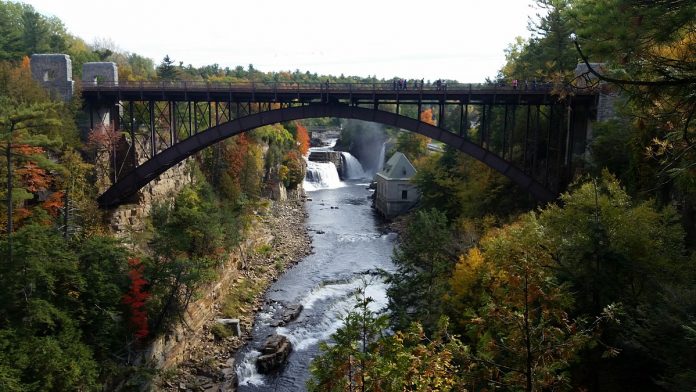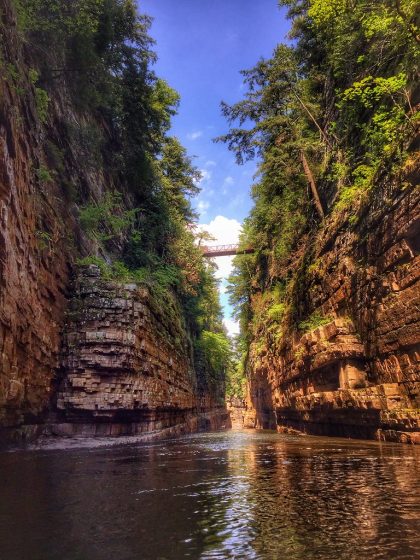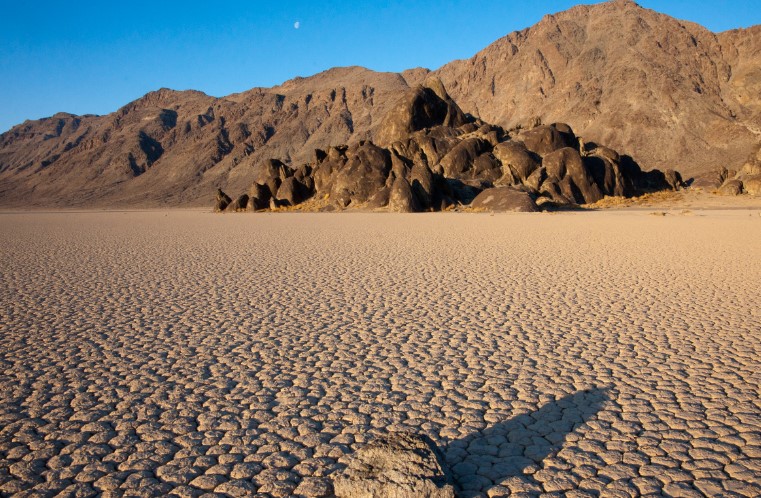Ausable Chasm in New York is a sandstone gorge and tourist attraction located near the hamlet of Keeseville in the United States. It is directly west of Port Kent. The Ausable River runs through it and then empties into Lake Champlain. The gorge is about two miles (3.2 km) long and is a popular tourist attraction in the Adirondacks region of Upstate New York.
Ausable Chasm is fed by the Rainbow Falls at its southern extreme. Ausable Chasm formed 500 million years ago when this area was covered in sand dunes. As the sand was worn away by water and wind, eventually Ausable Chasm was formed. Ausable Chasm” gets its name from the Ausable River, which flows through it and into Lake Champlain.
The average is about in-depth and is in places as deep as The Ausable River flows in an east-west direction, and the Ausable Chasm itself runs north-south for a length of 2 miles (3 km) from end to end with an average width of
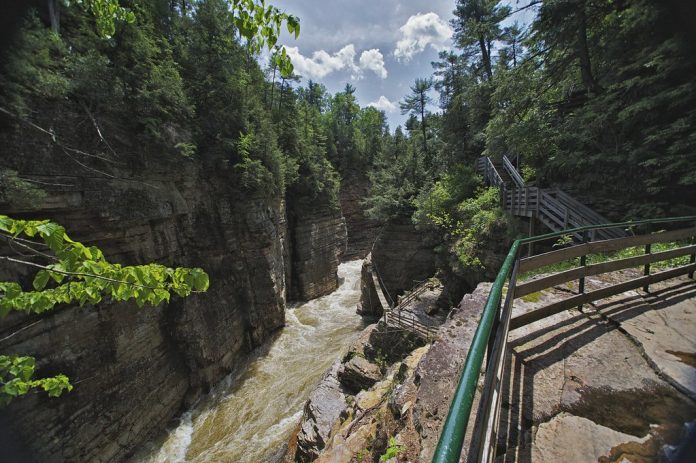
Ausable Chasm’s rock walls are made up of Potsdam Sandstone from the Cambrian Period, giving them their red color. There are several hiking trails that go along both sides of the Ausable River. But only one trail goes down into Ausable Chasm itself—the Ausable River Trail, a 2-mile path with a western entrance off Ausable Road and an eastern entrance off NY-73 near the Rainbow Falls trail. Ausable Chasm is open year-round from dawn to dusk for a small fee.
In 1869, John Roebling was brought in as a consultant to determine whether Ausable Chasm could be used as the source of power. The Ausable River needed to operate mills downstream if it were dammed at its exit from the chasm. After Roebling determined that Ausable Chasm was suitable for a powerhouse, he returned two years later to lay out plans for what would become known as Roebling’s Delaware Aqueduct.
One of four major suspension bridges he designed and built, which carried the Delaware and Hudson (D&H) Canal across the river near its outlet from Ausable Chasm. The bridge was completed in 1848 and is still open today to vehicular traffic.
Ausable Chasm in New York is also inspired by some of Washington Roebling’s design of the Brooklyn Bridge; his father designed and built an aqueduct similar to his Delaware Aqueduct (but smaller) that spanned Mill Brook Gorge in Easton, New York, about north of Ausable Chasm.
He called it Roebling’s Delaware Aqueduct, as he had for Ausable Chasm, but this one went over a brook instead of a river, as Ausable had. Both were suspension bridges, with their cables anchored at each end of the aqueduct. Ausable Chasm is about west of John Roebling’s masterwork, but Ausable Chasm is not open to vehicular traffic, while Roebling’s Delaware Aqueduct still carries railroad tracks over the river today.
Another interesting historical note about Ausable Chasm: Ausable Chasm was originally known as Gibbs Falls for an early settler in the area named Ebenezer Gibbs, who apparently had a cottage near Ausable Chasm itself. It is said that his daughter Phoebe fell into the gorge and died when she slipped on ice along its rim (hence, “Phoebe’s Fall”).

The tragedy supposedly inspired her grieving father to change his name from Gibbs to Au Sable (literally “sandy” in French). Ausable Chasm was then known as Gibbs Falls for many years afterward.
Ausable Chasm is located at latitude 44°24′11″ North and longitude 73°38′3″ West. Ausable Chasm is about due west of the hamlet of Keeseville, New York, and north-northwest of Port Kent, New York, on Ausable Road (Clinton County Route 22), which runs through Ausable Chasm itself. Ausable Chasm is fed by Rainbow Falls near its southern extreme.
The Ausable River Trail runs the length of Ausable Chasm from end to end along its north side. Ausable can be closed during ice events in winter months when the Ausable River freezes over. Ausable Chasm is the site of the annual Ausable Chasm Run, which has been held in September or October since 1978.
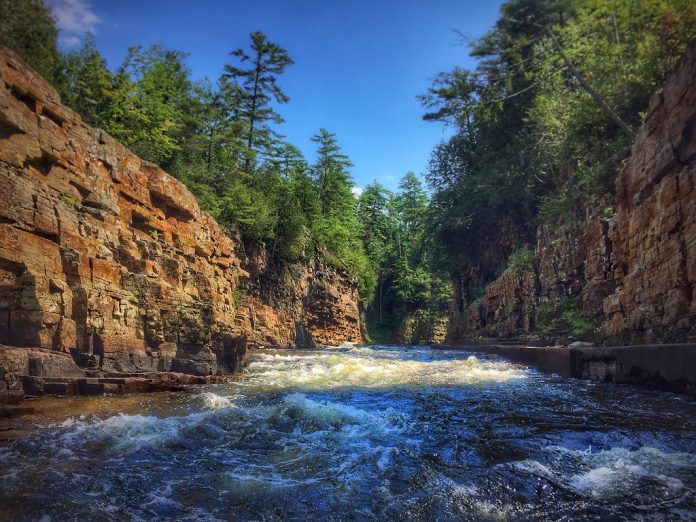
Ausable Chasm State Park also includes Lake Road Trail, which runs along the south side of the Ausable River for about 2 miles from its eastern portal near NY-73 to Huron Lookout at Ausable Point, where one can get spectacular views up and down Ausable Chasm itself as well as across Lake Champlain towards Vermont’s Green Mountains.
Ausable Point also gives fine views of Rainbow Falls cascading into Ausable Chasm along with its southern extreme. The steady flow rate of the Ausable River, combined with Ausable Chasm’s extensive underground fracture system, creates powerful hydraulic currents.
Lake Road Trail also provides access to the Ausable River from Ausable Chasm upriver for about 2 miles (3 km) to its confluence with Mill Brook, where that brook descends steeply through a gorge of its own into Lake Champlain at Ticonderoga, New York (and ultimately under the name of Bouquet River).

The Ausable River is part of New York’s Bouquet Fishway, an artificial fish ladder built in 1981 that allows trout and other migratory fish to bypass manmade barriers created by dams along the Ausable River, Ausable Chasm, and Lake Champlain.
Ausable Point also offers access to the Giant Mountain Wilderness Area, one of New York’s forest preserves. Ausable Chasm itself is about deep, while Giant Mountain rises steeply to an elevation of almost 4,000 feet (1,200 m) above Ausable Chasm. The Ausable River Trail includes a popular water slide in its upper course (just beyond the Ausable Chasm Railway).
Ausable River also has three major tributaries along its banks in Ausable Chasm State Park: Lazy Tom Brook that runs into Lake Road Trail at Ausable Chasm; Mill Brook that runs into Lake Road Trail just south of Ausable Point; and Indian Brook (also known as Moose Brook) that descends through the Ausable Marsh north of Port Kent, New York.
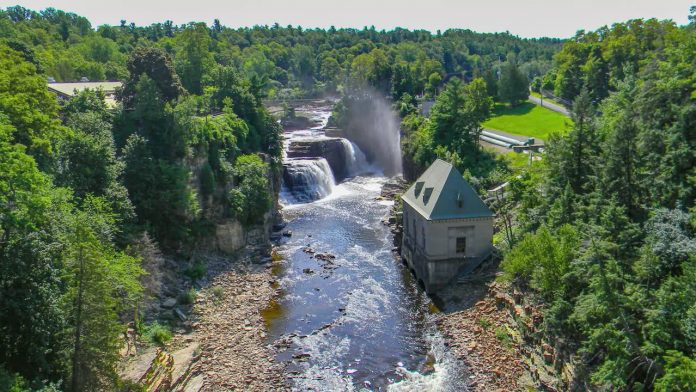
The eponymous “Ausable River” is part of the Saint Lawrence River drainage basin, being a tributary of Lake Champlain, which drains into Canada’s Richelieu River, then into the Saint Lawrence. Ausable Chasm itself lies within the Ausable River watershed; – Ausable River (NYS-73 Bridge to Ausable Chasm) has its headwaters at Giant Mountain Wilderness Area; and Ausable Marsh lies between Ausable Point and Ausable Chasm.
Indian Brook (also known as Moose Brook) has its headwaters on Camel’s Hump in Vermont; Lazy Tom Brook emptying into Lake Road Trail south of Ausable Point; Mill Brook draining Beaver Meadow southwest of Ausable Peak; and Mink Brook draining Crafts Pond southeast of Ausable Point.
Moreover, Booking.com is offering some of the best deals on the internet to book your hotel and avoid the hassles.
Booking.com
